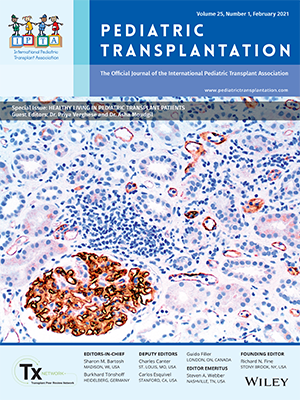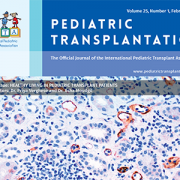Special issue of Pediatric Transplantation features Children’s National experts

While much has been written about advances in the field of pediatric transplantation, there have been relatively few publications that address the social, psychological and day‐to‐day struggles faced by pediatric transplant recipients and their families. A special February 2021 issue of the journal Pediatric Transplantation, guest edited by Children’s National Hospital nephrologist and medical director of transplant Asha Moudgil, M.D., features a compilation of articles from a diverse group of professionals who share their expertise on topics related to healthy living for pediatric solid organ transplant patients. Among these leaders in their fields are several clinicians from Children’s National, including Jonathan Albert, M.D. (Infectious Diseases fellow), Benjamin Hanisch, M.D. (Transplant Infectious Diseases), Kristen Sgambat, Ph.D., R.D. (Renal Dietician), Melissa R. Meyers, M.D. (Nephrologist) and Kaushalendra Amatya, Ph.D. (Psychologist).
In an editorial co-written with Priya Verghese, M.D., of Ann & Robert H. Lurie Children’s Hospital of Chicago, Dr. Moudgil writes, “It is widely acknowledged by those practicing in the field of transplant medicine that taking care of pediatric transplant recipients is a complex endeavor for all parties involved, including patients, families, and providers. In this compendium, we bring you expertise from a diverse group of professionals — including physicians, psychologists, social workers, and nutritionists. These authors provide a concise summary of the literature and evidence when available, and offer personal insight where there is paucity of literature in topics related to healthy living in pediatric transplantation.”
Dr. Albert, Dr. Hanisch and Sgambat provide their expertise in an article titled “Approaches to safe living and diet after solid organ transplantation,” which reviews the risks that pediatric and adolescent solid organ transplant recipients encounter through exposures such as household contacts, outdoor activities, travel, animal exposures and dietary choices.
Like their peers, transplant recipients go through challenges of sexual development, but are at greater risk for sexually transmitted diseases due to their chronic immunosuppression. To address this need, Dr. Meyers and colleagues provide an introductory sexual preventive care resource for adolescent and young adult solid organ transplant recipients in their article “Promoting safe sexual practices and sexual health maintenance in pediatric and young adult solid organ transplant recipients.”
And, in an article titled “Psychological functioning and psychosocial issues in pediatric kidney transplant recipients,” Dr. Amatya and colleagues analyze psychological and psychosocial factors related to medical outcomes and overall well‐being post‐transplant.
Pediatric Transplantation articles written by experts from Children’s National in the 2021 February issue:
- Healthy living in pediatric transplant recipients: What does it take? Asha Moudgil, M.D., Priya Verghese, M.D.
- Approaches to safe living and diet after solid organ transplantation. Jonathan Albert M.D., Benjamin Hanisch M.D., Kristen Sgambat R.D.
- Promoting safe sexual practices and sexual health maintenance in pediatric and young adult solid organ transplant recipients. Monica I. Ardura, DO, MSCS, Lisa A. Coscia, RN, BSN, CCTC, Melissa R. Meyers, M.D.
- Psychological functioning and psychosocial issues in pediatric kidney transplant recipients. Kaushalendra Amatya, Ph.D., Kara Monnin, Ph.D., Elizabeth Steinberg Christofferson, Ph.D.







